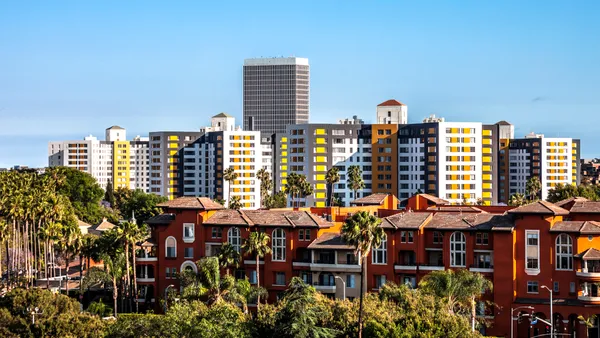Dive Brief:
- The national average asking rent rose by $15 in April, up to a new all-time record of $1,659, according to the latest monthly report by property data and analytics firm Yardi Matrix. Year-over-year rent growth fell back slightly in April, but remains high at 14.3%.
- Florida’s largest metro markets continue to show the strongest YOY rent growth out of the nation’s top 30, led by the Miami metro at 24.6% and followed by Orlando at 24.1% and Tampa at 22.6%. These three markets have maintained the strongest rent growth out of the top 30 since February 2022, while Phoenix, a top market in late 2021, has fallen to fifth place at 20.7%.
- While multifamily housing has continued its hot streak of growth into 2022, Yardi anticipates that the market will decelerate as the year progresses. “The U.S. economy unexpectedly contracted by 1.4% in the first quarter of 2022, owing to issues that include surging inflation, ongoing supply chain issues, shrinking business inventories and the omicron outbreak in January,” the report’s analysts said.
Dive Insight:
Inflation has risen to a 40-year-high, with the Consumer Price Index up 7.9% YOY in April 2022. The rising cost of commodities leads to an increase in the already-rising cost of building products - which leads, in turn, to an increase in the cost of housing.
The national average rent has risen quickly over the past year, up $260 since February 2021 and $50 this year to date. The average asking rent for a single-family home in the U.S. also rose to a record high in April at $2,018, but single-family rent YOY growth has fallen more than a full percentage point since March, down to 13.2%.
| Market | YOY Rent Growth, April 2022 | YOY Rent Growth, March 2022 | Change |
|---|---|---|---|
| Miami Metro | 24.6% | 26.3% | -1.9% |
| Orlando, Florida | 24.1% | 24.8% | -0.7% |
| Tampa, Florida | 22.6% | 23.8% | -1.2% |
| Las Vegas | 22.1% | 23.4% | -1.3% |
| Phoenix | 20.7% | 23.2% | -2.4% |
| Orange County, California | 19.7% | 19.7% | 0% |
| New York City | 18.3% | 17.8% | 0.5% |
| Austin, Texas | 18.1% | 19.9% | -1.8% |
| Raleigh, North Carolina | 17.9% | 18.3% | -0.4% |
| Nashville, Tennessee | 17.4% | 18.6% | -1.2% |
SOURCE: Yardi Matrix
Rising rents have done little to stem the tide of demand for multifamily housing, driven both by a lack of available units – particularly in metros where migration patterns have shifted as a result of pandemic-era lifestyle changes – and by a base of higher-income renters willing to pay more for the units that are available.
Housing analysts estimate that the U.S. lacks between 2 million and 5 million of the housing units it needs, and owes a shortage of new developments over the past decade to land constraints, high labor and material costs and reduced financing for housing projects following the Great Recession.
This shortfall is not expected to be permanent. Population growth has slowed, and housing starts have risen to an annualized rate of 1.8 million – well above the 40-year average of 1.4 million, according to Chris Porter, chief demographer at John Burns Real Estate Consulting, in remarks cited in the Yardi report. Still, responses to the NMHC’s quarterly construction survey reveal a rise in construction delays, labor costs and permitting, all headwinds against new construction in the near future.











